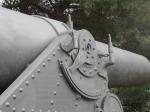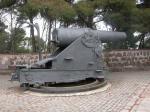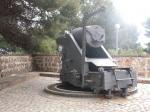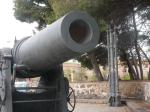Le 305MM Ordonez ( Barcelone)
English Translation
 |
Château de Montjuich
Barcelone est par la mer Méditerranée, est à une centaine de kilomètres de frontière française Les premières fortifications ont été construites par les Romains et des sections de la muraille romaine sont toujours debout. La ville s'étend au Moyen-âge et un nouveau mur d'enceinte est construit là aussi , une petite partie est encore conservé. En 1714 une citadelle e en forme d’étoile est construite par Felipe V, mais elle sera détruite au XIXème siècle pour créer le Parc de la Ciutadella.
Les principaux vestiges de fortification, existant est le fort de Montjuich situé sur la colline éponyme dominant Barcelone Commandant la ville et le port, les bastions du fort reçoivent une forte artillerie
Actuellement sont conservé une batterie de quatre canons de 152.4mm (6 ") 1923 Modèle Vickers coast defence guns ou canon de défense côtière. Sur les culasses sont gravées " C 15,24 cm Costa Modello 1923 Vickers CN Reinosa 1932 ".
Nous trouvons aussi quatre canons Ordonez 305 mm (12") 1892 qui ont précédé les Vickers.
Il y a aussi dans le Bloc central le poste d observation et de commandement en bêton armé
Histoire
A l'époque romaine le sommet de la colline de Montjuich était occupée par un temple romain. Entre le 6e et le 11e siècle, la colline fut le lieu de sépulture de la population juive locale avant leur expulsion de la ville à la fin du Moyen Age.
Le fort contient un certain nombre d'inscriptions lapidaires juives. Après l'expulsion de la population juive, une tour de guet est construite sur le sommet de la colline En 1640, pendant le soulèvement contre Felipe IV, un fortin de terre et de pierres a été construit.
Le premier fort a été agrandi en 1694. Pendant la guerre de Succession d’Espagne, le fort a été assiégé capturé à deux reprises.
En 1751 les travaux commencent sous la direction de l'ingénieur militaire Juan Martin Cermeflo pour transformer le fort au sommet de la colline de Montjuich en un puissant complexe fortifié
Le travail est terminé en 1799 . Actuellement c’est cet ouvrage qui est conservé Durant la Guerre Civile Espagnole (1936 1939) , les bâtiments étaient utilisés comme une prison, et les exécutions de prisonniers nationalistes ont eu lieu dans le fossé Saint-Elena. Lorsque Franco prit le pouvoir il servi à la même chose ( prison et lieu d exécution)
Une grande partie de l'ouvrage est actuellement visitable . C’est un muée militaire de grande richesse
La cour contient également un certain nombre d'armes à feu,
Les canons conservés à l extérieur du Fort firent partie de la 1° batterie du 7e Régiment d’artillerie côtière
La date de l installation de cette batterie est incertaine mais elle doit daté de juste après la Guerre Civile
305 mm canon Ordonez Château de Montjuich
Le système de recul relie l’affut au plan incliné qui recule contre des bossoirs Nous trouvons aussi une grue pour la manutention des obus
Château de Montjuich.
152.4 mm Vickers de defense cotiere
305mm Ordonez Barcelona Castle of Montjuich.
 |
Barcelona lies by the Mediterranean Sea, is at one hundred kilometers from French border The first fortifications were built by the Romans and sections of the Roman wall survive. The city expanded in the Middle Ages and a new city wall was built, a small section of which survives. In 1714 a star-shaped citadel was built by Felipe V, later to be destroyed in the 19th century to create the Parc de la Ciutadella. The main fortification work, however, is known as the Castle of Montjuich situated on the dominating hill of that name. Commanding the town and port, the bastions of the fort (for that is what it is) provide bases for a battery of four I 52.4mm (6") 1923 model Vickers coast defence guns. The breeches are inscribed "C 15,24cm Costa Modello Vickers 1923 C.N Reinosa 1932". Also present are four Ordonez 305 mm (12") 1892 model guns, the predecessors of the Vickers guns.
On the traverse of the central block lies the concrete battery observation post.In Classical times the hill of Montjuich was occupied by a Roman temple. Fr6m the 11th century the hill was the burial ground of the local Jewish population until their expulsion from the city in the later Middle Ages. The fort contains a number of inscribed stones from the Jewish period. Following the expulsion of the Jewish population a watchtower wasbuilt upon the hill.In 1640, during the uprising against Felipe IV, a small fort of earth and stones was built. The earlier fort was enlarged in 1694. During the War of Succession the fort was twice besieged and captured. In 1751 work began under the direction of the military engineer Juan Martin Cermeflo to transform the top of the hill of Montjuich into a bastion- trace fortification. The work was finally finished in 1799 and the appearance of the fort today is largely the same as it was at the end of the 18th century. In the Spanish Civil War the buildings were used as a prison, and executions of Nationalist prisoners took place in the St. Elena ditch.
When Nationalis were at the party in power it was the same things but with the republicans in the role of convict or prisoners
There are excellent displays of weapons and uniforms as well as relief models of the major Catalan fortifications.
The Vickers guns formed the First Battery of the Seventh Regiment of Coastal Artillery. The date of the installation of the Vickers battery is not clear: Thye will be installed in the mid4940s.
305 mm Ordonez gun Castle of Montjuich
The recoil system relied on the carriage of the gun running up an inclined plane against buffers We found also a crane for shell hoisting
Castle of Montjuich.
152.4 mm Vickers coast defence gun.











.jpg)
.jpg)
.jpg)
.jpg)